
The Amiga 500, also known as the A500, is the first low-end version of the Amiga home computer. It contains the same Motorola 68000 as the Amiga 1000, as well as the same graphics and sound coprocessors, but is in a smaller case similar to that of the Commodore 128.

The Motorola 68030 ("sixty-eight-oh-thirty") is a 32-bit microprocessor in the Motorola 68000 family. It was released in 1987. The 68030 was the successor to the Motorola 68020, and was followed by the Motorola 68040. In keeping with general Motorola naming, this CPU is often referred to as the 030.

The Motorola MC68010 processor is a 16/32-bit microprocessor from Motorola, released in 1982 as the successor to the Motorola 68000. It fixes several small flaws in the 68000, and adds a few features.
DNIX is a discontinued Unix-like real-time operating system from the Swedish company Dataindustrier AB (DIAB). A version named ABCenix was developed for the ABC 1600 computer from Luxor. Daisy Systems also had a system named Daisy DNIX on some of their computer-aided design (CAD) workstations. It was unrelated to DIAB's product.

The Amiga 2000, or A2000, is a personal computer released by Commodore in March 1987. It was introduced as a "big box" expandable variant of the Amiga 1000 but quickly redesigned to share most of its electronic components with the contemporary Amiga 500 for cost reduction. Expansion capabilities include two 3.5" drive bays and one 5.25" bay that could be used by a 5.25" floppy drive, a hard drive, or CD-ROM once they became available.
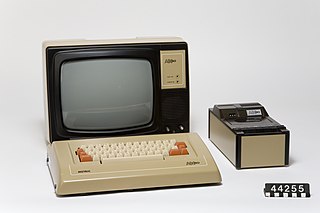
The ABC 80 was a personal computer engineered by the Swedish corporation Dataindustrier AB (DIAB) and manufactured by Luxor in Motala, Sweden in the late 1970s and early 1980s. It was introduced on the market in August 1978.

The Macintosh LC II is a personal computer designed, manufactured, and sold by Apple Computer from March 1992 to March 1993. The LC II is an update to the original Macintosh LC, replacing its Motorola 68020 processor with a 68030 and increasing the onboard memory to 4 MB. The LC II was priced at US$1,699, fully $800 less than the original LC when it was introduced.

The Atari Falcon030, released in 1992, was the final personal computer from Atari Corporation. A high-end model of the Atari ST line, the machine is based on a Motorola 68030 CPU and a Motorola 56001 digital signal processor, which distinguishes it from most other microcomputers of the era. It includes a new VIDEL programmable graphics system which greatly improves graphics capabilities.
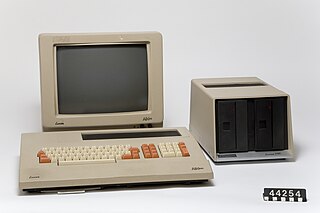
The Luxor ABC 800 series are office-versions of the ABC 80 home computer. They featured an enhanced BASIC interpreter, a slightly faster clocked CPU and more memory: 32 kilobytes RAM and 32 KB ROM was now standard, the Z80 is clocked at 3 MHz. It featured 40×24 text mode with eight colors or 80×24 text mode monochrome. They could also be extended with "high" resolution graphics using 16 KB RAM as video memory.
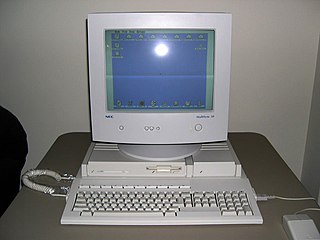
The Atari TT030 is a member of the Atari ST family, released in 1990. It was originally intended to be a high-end Unix workstation, but Atari took two years to release a port of Unix SVR4 for the TT, which prevented the TT from ever being seriously considered in its intended market.

The Macintosh Quadra 950 is a personal computer designed, manufactured and sold by Apple Computer from March 1992 to October 1995. It replaced the Quadra 900 that was introduced several months earlier, increasing the CPU clock rate of its 68040 CPU from 25 MHz to 33 MHz, and improving the graphics support. The two computers were otherwise identical, including the price. With a Macintosh Processor Upgrade Card installed, this computer is known as the Power Macintosh 950.
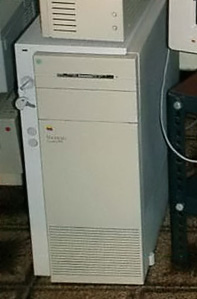
The Macintosh Quadra 900 is a personal computer designed, manufactured, and sold by Apple Computer from October 1991 to May 1992. It was introduced alongside the Quadra 700 as the first computers in the Quadra family of Macintosh computers using the Motorola 68040 processor. It is also the first computer from Apple to be housed in an 18.6 inch tall mid-tower form factor, which by 1991 had gained momentum with PC manufacturers as a suitable design for departmental servers.

The Macintosh Quadra 650, originally sold as the Macintosh Centris 650, is a personal computer designed, manufactured and sold by Apple Computer from February 1993 to September 1994. The Centris 650 was introduced alongside the smaller Centris 610 as the replacement for the Macintosh IIci and Quadra 700, and it was intended as the start of the new midrange Centris line of computers. Later in 1993, Apple decided to follow an emerging industry trend of naming product families for their target customers – Quadra for business, LC for education, and Performa for home – and folded the Centris 650 into the Quadra family.

The AT&T UNIX PC is a Unix desktop computer originally developed by Convergent Technologies, and marketed by AT&T Information Systems in the mid- to late-1980s. The system was codenamed "Safari 4" and is also known as the PC 7300, and often dubbed the "3B1". Despite the latter name, the system had little in common with AT&T's line of 3B series computers. The system was tailored for use as a productivity tool in office environments and as an electronic communication center.

The PowerBook Duo 230 is a subnotebook personal computer introduced on October 19, 1992 by Apple Computer, Inc. Priced at US $2,610, the PowerBook Duo 230 was the high end model of the two simultaneously released PowerBook Duos, the lower end being the US $2,250 PowerBook Duo 210. With a 33 MHz Motorola 68030 microprocessor, 4 MB of RAM and an 80 or 120 MB SCSI hard disk drive, the PowerBook Duo 230 was nearly identical to the simultaneously released PowerBook 180 except for the smaller 9.1 inch greyscale "supertwist" passive-matrix LCD and the lack of a 68882 floating-point unit.
Torch Computers Ltd was a computer hardware company with origins in a 1982 joint venture between Acorn Computers and Climar Group that led to the development of the Communicator or C-series computer, a system based on the BBC Micro with a Z80 second processor and integral modem, intended as a viewdata terminal.
Cromemco was a Mountain View, California microcomputer company known for its high-end Z80-based S-100 bus computers and peripherals in the early days of the personal computer revolution.

Altos Computer Systems was founded in 1977 by David G. Jackson and Roger William Vass Sr. It focused on small multi-user computers, starting with multi-user derivatives of CP/M, and later including Unix and Xenix-based machines. In its 1982 initial public offering on NASDAQ, the company raised $59M. Thereafter the company's stock was traded under the symbol ALTO.
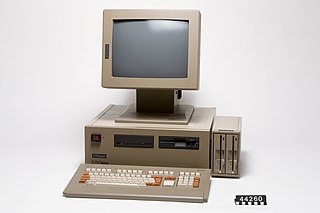
The ABC 1600 was a personal computer from Luxor that was introduced in 1985. It was built around the Motorola 68008 processor, had 1 megabyte of memory and used the operating system ABCenix, a Unix-like system developed from DNIX.

The Dimension 68000 is a microcomputer introduced by the Micro Craft Corporation in 1983 that sought to emulate the Apple II, the IBM PC, and various CP/M-centric computers through a family of coprocessor expansion cards and emulation software. The Dimension 68000 can also run as a standalone computer based on the Motorola 68000 from which it gets its namesake. The computer is mostly the brainchild of Mike Carpenter, a former executive of a scientific instrument manufacturer who incorporated Micro Craft in Dallas, Texas, to develop the Dimension 68000. It had a market lifespan of three years and received mixed, mostly positive, reception from the technology press. Criticism was leveled at the $6,250 price tag for the computer with the full deck of coprocessor cards, as well as the extent of the emulation power of those cards.


















